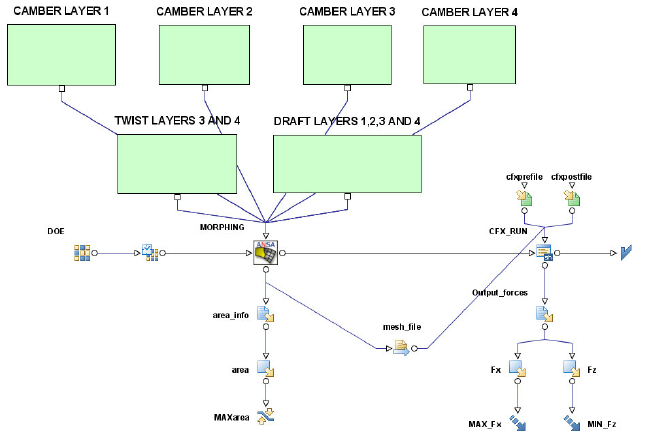Mastering Optimization Techniques in ModeFrontier: A Comprehensive Guide

Introduction: Optimization is at the heart of engineering and scientific endeavors, allowing practitioners to find the best possible solution to complex problems. ModeFrontier, a powerful multidisciplinary optimization software, provides a comprehensive platform for conducting optimization studies across various domains. In this extensive guide, we will delve into the intricacies of ModeFrontier, exploring its features, methodologies, and best practices for achieving optimal results.
Section 1: Understanding ModeFrontier
1.1 Overview of ModeFrontier: ModeFrontier is a versatile optimization and design exploration software developed by ESTECO, tailored to meet the diverse needs of engineers, researchers, and designers. It offers a user-friendly interface coupled with advanced optimization algorithms to tackle complex optimization problems efficiently.
1.2 Key Features:
- Multi-objective Optimization: ModeFrontier supports the optimization of multiple conflicting objectives simultaneously, enabling users to explore trade-offs and identify Pareto-optimal solutions.
- Integration Capabilities: It seamlessly integrates with various simulation tools, CAD software, and other engineering applications, allowing for automated workflow execution.
- Design Space Exploration: ModeFrontier facilitates the exploration of the design space by enabling the definition of design variables, constraints, and objectives.
- Optimization Algorithms: It offers a rich set of optimization algorithms, including genetic algorithms, particle swarm optimization, and response surface methodology, catering to different problem characteristics.
- Data Visualization: ModeFrontier provides powerful visualization tools to analyze optimization results, aiding in decision-making and insight generation.
1.3 System Requirements: Before diving into optimization tasks, it’s crucial to ensure that your system meets the hardware and software requirements specified by ModeFrontier to guarantee optimal performance.
Section 2: Setting Up Optimization Workflows
2.1 Defining the Optimization Problem: The first step in performing optimization in ModeFrontier is to clearly define the problem statement, including objectives, constraints, and design variables. This step lays the foundation for constructing the optimization workflow.
2.2 Workflow Creation: ModeFrontier offers a graphical workflow editor where users can design optimization workflows by defining components such as design variables, objectives, constraints, and simulation tasks. This visual approach simplifies the construction of complex optimization processes.
2.3 Integration with Simulation Tools: Leveraging ModeFrontier’s integration capabilities, users can seamlessly connect simulation tools and external software to the optimization workflow. This integration streamlines the execution of simulations and data exchange, enabling efficient optimization iterations.
2.4 Parameterization and Sensitivity Analysis: Before initiating optimization runs, it’s essential to perform parameterization and sensitivity analysis to understand the impact of design variables on the objectives and constraints. ModeFrontier provides tools for conducting sensitivity analysis, aiding in the selection of appropriate optimization strategies.
Section 3: Implementing Optimization Strategies
3.1 Single-Objective Optimization: Single-objective optimization aims to optimize a single objective function subject to constraints. ModeFrontier offers a variety of optimization algorithms, including gradient-based methods and evolutionary algorithms, to tackle single-objective optimization problems efficiently.
3.2 Multi-Objective Optimization: Multi-objective optimization involves optimizing multiple conflicting objectives simultaneously, often leading to a set of Pareto-optimal solutions. ModeFrontier provides specialized algorithms such as NSGA-II and MOGA-II for multi-objective optimization, allowing users to explore trade-offs and identify optimal solutions.
3.3 Response Surface Methodology (RSM): Response surface methodology is a powerful technique used to approximate complex simulation models with computationally efficient surrogate models. ModeFrontier integrates RSM into the optimization workflow, enabling rapid evaluations and smoother convergence towards optimal solutions.
3.4 Hybrid Optimization Strategies: Hybrid optimization strategies combine multiple optimization techniques to leverage their respective strengths and overcome limitations. ModeFrontier supports the implementation of hybrid optimization strategies, allowing users to customize workflows and combine algorithms for enhanced performance.
Section 4: Analyzing and Interpreting Results
4.1 Visualization Tools: ModeFrontier provides comprehensive visualization tools to analyze optimization results and gain insights into the design space. Users can visualize Pareto fronts, convergence plots, sensitivity analyses, and other relevant metrics to assess the quality of solutions and make informed decisions.
4.2 Trade-Off Analysis: With ModeFrontier’s support for multi-objective optimization, users can conduct trade-off analysis to understand the relationships between competing objectives. Visualizing trade-off surfaces and interactive Pareto fronts facilitates decision-making by highlighting optimal trade-offs based on user preferences.
4.3 Post-Processing and Reporting: Post-processing capabilities in ModeFrontier enable users to generate detailed reports summarizing optimization results, including optimal solutions, sensitivity analyses, convergence behavior, and design space exploration. These reports serve as valuable documentation for stakeholders and decision-makers.
Section 5: Best Practices and Tips
5.1 Define Clear Objectives and Constraints: Clearly defining objectives and constraints is essential for successful optimization studies. Ambiguous or conflicting objectives can lead to suboptimal solutions and hinder the convergence of optimization algorithms.
5.2 Utilize Parallel Computing: ModeFrontier supports parallel computing, allowing users to harness the computational power of multiple processors or clusters for faster optimization runs. Utilizing parallel computing can significantly reduce the time required to explore the design space and converge towards optimal solutions.
5.3 Validate Simulation Models: Before integrating simulation models into the optimization workflow, it’s crucial to validate their accuracy and reliability. Performing model validation ensures that optimization results are based on trustworthy simulations, minimizing the risk of erroneous conclusions.
5.4 Iterative Refinement: Optimization is often an iterative process that requires multiple refinement cycles to converge towards optimal solutions. Iteratively refining design variables, constraints, and objectives based on insights gained from previous optimization runs can lead to improved performance and robust designs.
Conclusion: Mastering optimization techniques in ModeFrontier empowers engineers, researchers, and designers to tackle complex design challenges and achieve superior outcomes across various domains. By leveraging its advanced features, integration capabilities, and optimization algorithms, users can streamline workflow automation, explore the design space effectively, and make informed decisions to drive innovation and competitiveness. With continuous advancements in optimization methodologies and software capabilities, ModeFrontier remains at the forefront of enabling transformative optimization solutions for diverse applications.





